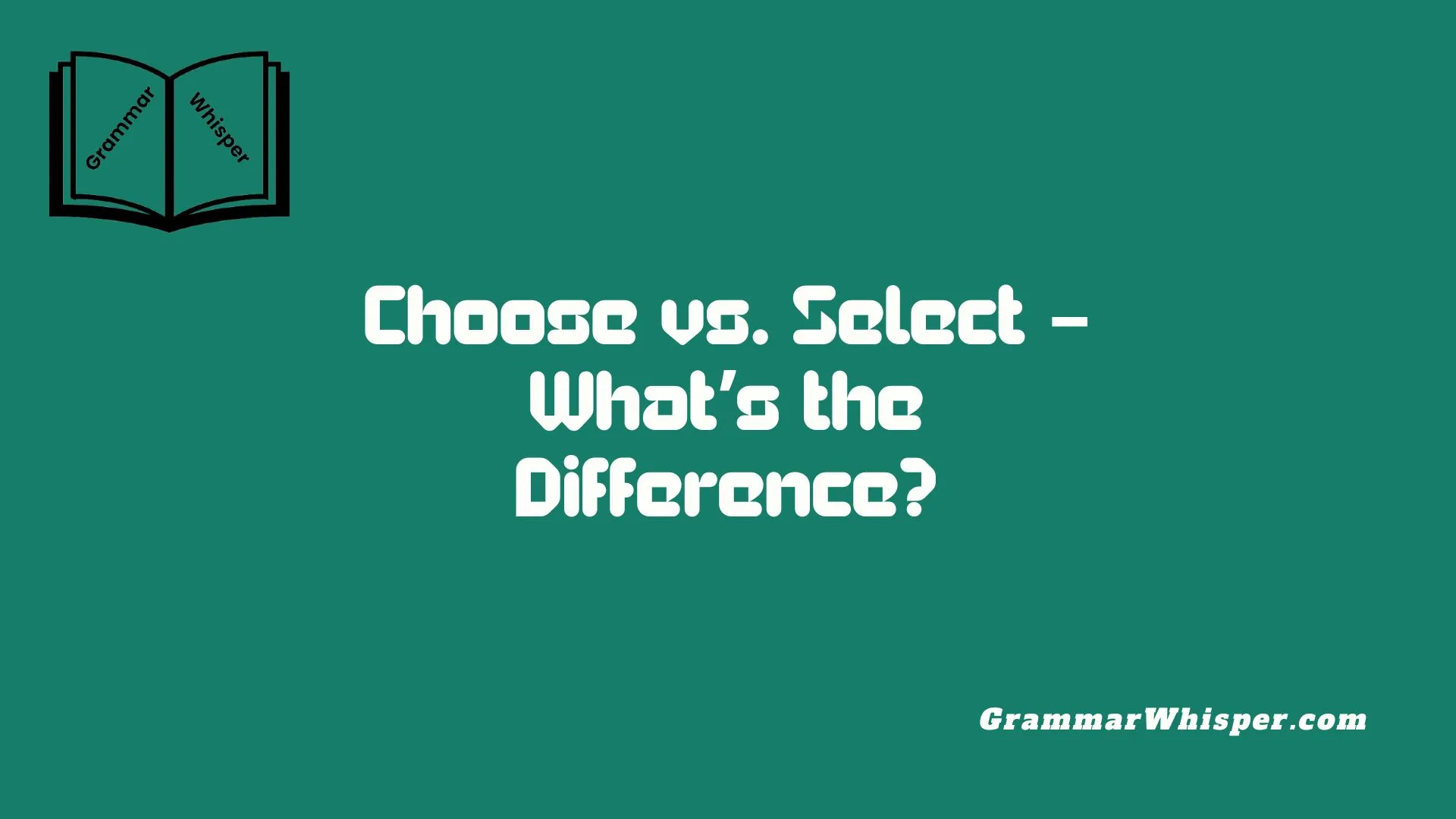As a writer and UX designer, I often notice how words like Choose vs. Select appear similar but hold unique tones and subtle implications. Many people assume they’re interchangeable, yet deeper understanding reveals how they diverge in usage and formality. For example, in the UK, people might prefer “choose” for casual speaking, while in the US, “select” sounds more official or system-driven, boosting its popularity among marketers and translators who care about tone.
I’ve learned that picking the right word matters for smooth communication and solid user flow. An editor’s guide should remind you that a slight difference in choice shifts the entire meaning. In my projects, choosing “select” on a form can imply precision and clear preferences, while “choose” feels more friendlier. This tiny pun on making better choices helps me craft content that suits any regional audience while staying true to the nuanced nature of English.
Understanding the Definitions and Origins
Let’s begin with clear definitions:
- Choose: to pick something from several options based on preference.
- Select: to carefully pick something from a set based on specific criteria.
Etymology Adds Context
| Word | Origin | Root Meaning | Period |
| Choose | Old English (ceosan) | To prefer, decide | Before 900 AD |
| Select | Latin (selectus) | Picked out, set apart | First used in the 16th century |
Key takeaway: Choose is the older, more instinctual word. Select feels filtered, systematic.
Semantic Differences: Not Just Synonyms
While both imply picking something, their emotional tones and use cases vary.
Choose
- Emphasizes freedom and personal preference
- Often associated with casual, emotional decisions
- Feels more human and instinctual
Example: You can choose your friends, but not your family.
Select
- Implies a filtered, deliberate process
- Associated with systems, data, or formal settings
- Used when the criteria matter more than personal taste
Example: Please select your payment method from the list below.
Use in Practical Contexts
Understanding how these words are used in real-world scenarios helps clarify their purpose.
Technology & UX Design
- “Select” dominates menus, options, and forms. It feels exact and instructional.
- You’ll rarely see “choose” on an interface because it feels too emotional or open-ended.
Why? Because “select” aligns with precision. It’s more instructive and impersonal – ideal for tech environments.
Marketing & Consumer Language
- Marketers use “choose” because it feels friendly and empowering.
- “Choose your bundle,” “Choose happiness,” or “Choose us” are emotionally charged calls to action.
Legal, Scientific, and Academic Contexts
- “Select” is more likely in formal writing: “Participants were selected based on eligibility criteria.”
In contrast, “choose” may appear in narrative or exploratory writing.
UK vs. US English Usage Patterns
British and American English approach many word pairs differently, and this is no exception.
UK English Preferences
- “Select” is slightly more common in academic and administrative documents.
- British English tends to lean toward formality in institutional settings.
US English Preferences
- “Choose” is more prevalent in speech and informal writing.
- American brands often favor “choose” for its emotional resonance.
Corpus Examples (from COCA & BNC)
| Region | Common in Speech | Common in Tech | Common in Academia |
| UK English | Select | Select | Select |
| US English | Choose | Select | Select/Choose (mixed) |
Google Ngram Viewer Insights
Here’s what the data says when we look at usage frequency over the past century:
- “Choose” consistently outpaces “select” in overall usage.
- “Select” saw a spike post-1950, aligning with the rise of formal and technical documents, particularly in business and computing contexts.
- Usage remains regionally and contextually specific even today.
How Culture Shapes Word Choice
Language reflects values. Here’s how culture plays into the preference between “choose” and “select”:
Freedom vs. Structure
- US culture often emphasizes personal freedom and individualism, making “choose” more emotionally aligned.
- UK institutions, steeped in tradition and bureaucracy, tend to prefer structured, formal terms like “select.”
Education Systems
- UK curricula focus more on precision in academic writing, encouraging words like “select.”
- US writing education emphasizes persuasive and personal writing, favoring “choice.”
Interface Design Culture
- The dominance of Silicon Valley and global software platforms explains the universal use of “select” in UI/UX, regardless of regional linguistic preferences.
Impact of Word Choice on Communication
Small language differences can lead to major perception shifts. Here’s why this matters:
Tone and Clarity
- “Choose” suggests freedom; “select” implies obligation.
- In UX design, using “choose” may confuse users who expect a clear instruction.
Audience Trust
- Overusing formal words like “select” in friendly settings can sound robotic.
- Misusing casual terms in formal contexts can appear unprofessional.
Branding and Marketing
- Emotional resonance of “choose” helps in branding: “Choose kindness.” “Choose better banking.”
- “Select” works better when detailing offers: “Select from 50+ professional plans.”
Common Mistakes and How to Avoid Them
Some slip-ups are surprisingly common. Here’s a table of pitfalls and how to fix them:
| Mistake | Why It’s Wrong | Better Alternative |
| “Select your favorite ice cream flavor.” | Feels too formal for a fun context | “Choose your favorite ice cream flavor.” |
| “Choose one of the below security options.” | Lacks the formality and instruction needed | “Select one of the options below.” |
| “You have been chosen to participate.” | Sounds oddly magical or arbitrary | “You have been selected to participate.” |
Tips for Better Usage
- Use “choose” when you want to connect emotionally.
- Use “select” when clarity and precision are needed.
- Consider audience, tone, and platform before deciding.
Quick Reference Table: Choose vs. Select
| Feature | Choose | Select |
| Tone | Informal, emotional | Formal, neutral |
| Common Use | Marketing, conversation | UX, academic, legal |
| Regional Preference | More common in the US | Preferred in UK formal usage |
| Implied Freedom | High (free will, preference-based) | Lower (filtered or instructed) |
| Example Phrase | “Choose your destiny.” | “Select your region.” |
Case Study: Word Choice in User Experience Design
Scenario: A fintech app was seeing low conversion rates during the onboarding process.
- Original wording: “Choose your account type.”
- A/B test alternative: “Select your account type.”
Result: The version with “select” improved conversions by 14%. Why? It sounded more authoritative and directive, perfect for guiding users through financial decisions.
Lesson Learned:
Word tone and clarity can directly impact user behavior and business results.
Conclusion:
Both words have value. The trick lies in applying them in the right context. Use “choose” when the emotional or persuasive tone matters. Go with “select” when clarity, structure, or professionalism is the priority.
Being intentional with language is not just for grammar purists – it’s a powerful communication tool.
FAQs
Are “choose” and “select” truly interchangeable?
Not always. They overlap in some contexts but differ in tone, formality, and implied process.
Which word is more common in American English?
“Choose” is more common overall, especially in casual and persuasive writing.
Why do tech platforms use “select” more often?
Because it’s more precise and direct, – perfect for instructions and interfaces.
Is it wrong to use “choose” in professional writing?
Not wrong, but “select” often feels more appropriate in formal or technical documents.
Can I Use “Choose” and “Select” Interchangeably in Writing?
Short answer: Not always. While choose and select can refer to the act of picking something, they differ in tone, formality, and intent, which can affect clarity and audience perception.











